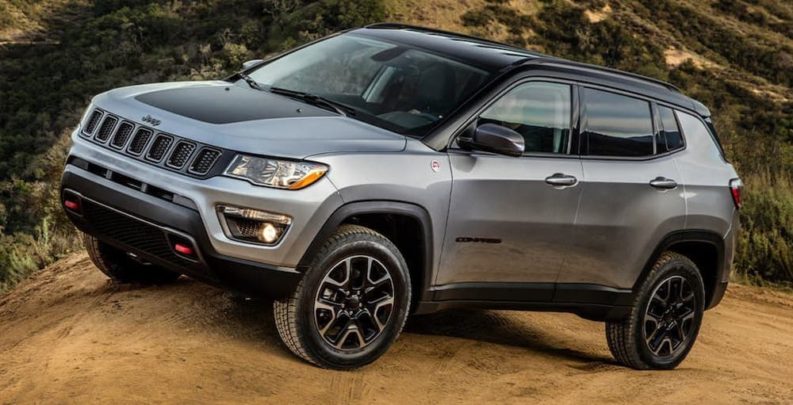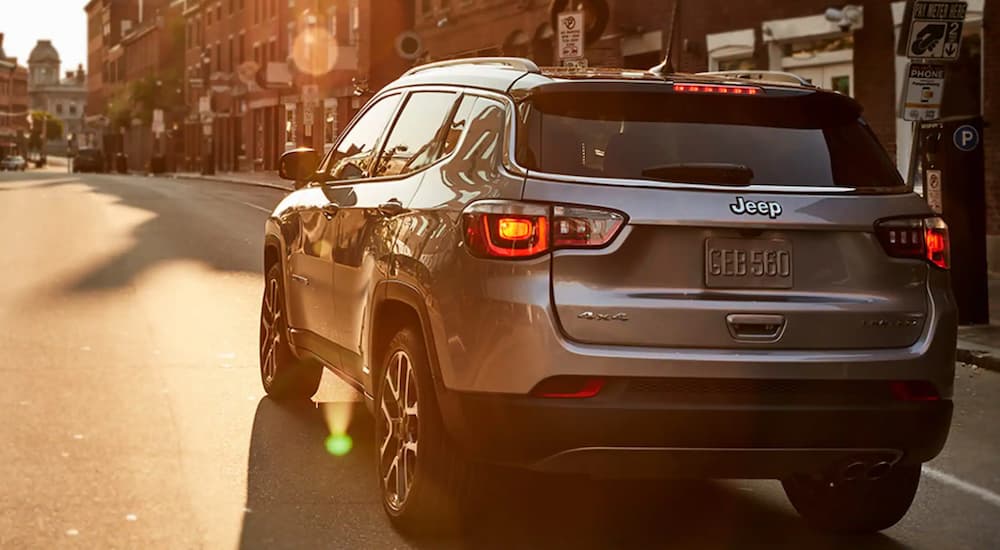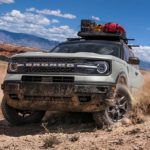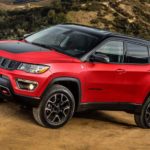Unibody SUVs are almost never meant to venture out anywhere beyond the mall parking lot. Emphasis on almost. The Jeep Compass Trailhawk and Ford Bronco Sport are built like a car in terms of their comfort and convenience but have a surprisingly large amount of trail-conquering, dirt-slinging, creek-fording ability.
The Badlands variant of the Bronco Sport is especially capable when off the beaten path. And yet, in several important ways, the Compass manages to surpass its fellow crossover SUV – and even better, the long-running Compass can be found at an affordable price at your local used Jeep dealer. Why is the Jeep Compass Trailhawk better than the Ford Bronco Sport Badlands? Well, let’s find out.
Off-Road Capability
The headline features, and indeed names, of both the Bronco Sport Badlands and Compass Trailhawk relate to their ability to move over and beyond terrain that normal cars and crossover SUVs would have a lot of trouble with. Both the Trailhawk and Badlands trims offer far more than just stickers. Both vehicle’s off-road-focused trim levels pack in new suspension components, specialized tires, and more.
But what begins to stick out when pouring over the spec-sheets of both is that despite very similar equipment being offered across the board, the Jeep always seems more affordable – even without visiting a used Jeep dealer. Both vehicles have higher ground clearance and upgraded suspension when compared to standard crossovers, yet the Jeep comes in at a noticeably more affordable price. This is despite said suspension offering almost exactly the same amount of ground clearance. Additionally, the all-terrain treads both SUVs wear are almost identical in size and profile, yet the Jeep again has a lower price that includes all those features. The Badlands Bronco is no less capable, but it is more expensive for the same pieces of kit.
The same is true for important features like differing terrain modes and 4×4 capabilities. Both the Trailhawk and Badlands can change important settings and systems on the fly to account for different terrains and maximize traction. Both mainly do this through driver-selected modes, where the driver selects the type of terrain and the vehicle changes settings accordingly. The feature is standard on both the Compass Trailhawk and Bronco Sport Badlands, but the Trailhawk remains less expensive. Both vehicles feature full 4×4 systems that can completely deactivate and become 4×2 for the sake of fuel economy, and both of said systems have specific features that all them to be much more effective off-road. But the Jeep remains more attainable.
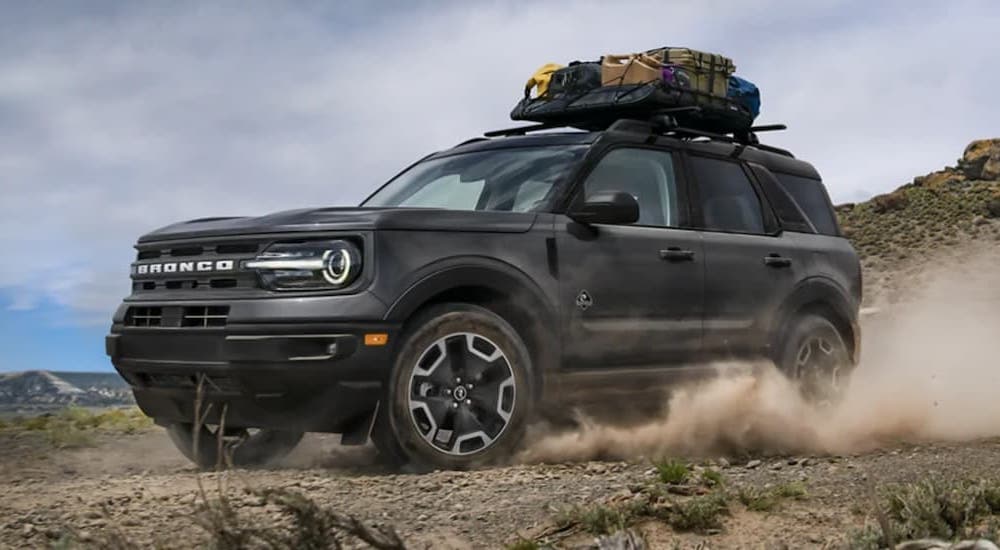
Interior Features
On the inside, both the Bronco and Compass Trailhawk are quite well equipped. Incorporating by default many of the features found on high trim levels, these vehicles are just as much about comfort and amenities as they are about off-road capabilities. The technology on display in the Bronco and Compass is just as good as any other currently available mass-production car, and in some cases, better.
Both the Ford Bronco Sport Badlands and the Jeep Compass Trailhawk feature their respective automaker’s latest and greatest infotainment operating systems. In the Badlands’ case, that is SYNC 3, while in the Trailhawk, it is the fresh UConnect 4C, which includes navigation. Both vehicles present these systems to the driver with easy-to-access touchscreen controls, though the Compass Trailhawk’s touchscreen is a touch larger.
While a multitude of apps and features are available through both vehicle’s screens, one of the standout features that both vehicles have is the direct integration of Apple CarPlay and Android Auto capability. Easily and seamlessly connecting phones to the vehicle’s infotainment system, these abilities make it a snap to stream music and take advantage of other features.
In the Compass Trailhawk’s case, that audio could be streamed into the available Alpine nine-speaker premium sound system that includes a subwoofer. Further interior comforts include heated and ventilated front seats, as well as a heated steering wheel. The Bronco’s interior is a nice place to be, but the Compass Trailhawk adds more luxury features and abilities, not to mention multiple color options and avenues for personalization.
Powertrain Options
The engine of the Badlands is quite the powerplant, displacing two liters and including a turbocharger for added muscle. Engine power is one of the few true advantages the Bronco Sport Badlands has over the Compass Trailhawk, though at lower trim levels, that advantage dissipates as the Bronco Sport comes standard with a smaller 1.5-liter engine, while every Compass has the 2.4-liter Tigershark. Similar to the 2.0-liter EcoBoost powering the Badlands, the 2.4-liter Tigershark engine in the Compass is thoroughly modern.
Both engines are completely aluminum in construction and feature advanced electronic controls and variable timing. These measures allow the engines to make the most of every drop of fuel given to them, both in terms of power and efficiency. In addition to all of that power and efficiency, both engines comply with stringent safety and emissions standards, meaning they are approaching the maximum amount of cleanliness possible with internal combustion engines. While the Badlands’ EcoBoost engine is indeed more powerful, the Tigershark has the advantage of being simpler due to not having a turbocharger.
For most people who buy an off-road capable crossover SUV, the 2.4-liter Tigershark will be enough, and it will also provide better fuel economy and efficiency than the more powerful turbocharged EcoBoost engine. It becomes a question of priorities. For those who will be using their vehicle’s abilities on a weekly basis, the powerful engine might be worth the tradeoff in efficiency. But for most people, whose trail experience will be more limited, the Tigershark offers a more fitting set of attributes.
Chassis and Design
Both the Jeep Compass Trailhawk and Bronco Sport Badlands feature car-like unibody construction, making them “crossover” SUVs. Crossovers are SUVs that are not built on a truck-style ladder frame but instead use the body as the frame. This type of construction minimizes weight and maximizes material efficiency. The benefits of lesser weight are significant, especially in terms of fuel economy.
Traditionally, unibody crossovers have not been as capable off-road as their full-frame standard SUV and pickup truck counterparts, but both the Jeep Compass Trailhawk and Bronco Sport Badlands offer different suspension setups and more capable four-wheel drive systems than normal crossovers.
The changed suspension components result in increased ride height, increased breakover angle, and better approach and departure angles, while at the same time offering more suspension travel to handle undulating terrain. Breakover angle is essentially a measure of how tall an obstacle under the vehicle can be before the vehicle is “high centered” – that is, stuck on something tall enough that it raises the front and rear wheels off the ground. Approach and departure angles are the angles of terrain change the vehicle can drive over without scrubbing the front or rear bumper on the ground. The suspension changes on both the Jeep and Bronco also allow them to handle tougher terrain.
Jeep Still Reigns Supreme
For some, being the most hardcore off-roader possible isn’t practical. The Compass Trailhawk has practically all the off-road, interior, and chassis features of the Bronco Sport Badlands, but at a lower cost – especially if you shop used. And that lower cost isn’t just the purchase price, but running costs as well, as the Trailhawk gets much better gas mileage than its Ford rival. Both of these vehicles are well built for their intended purpose, but the Compass remains the better runabout.

